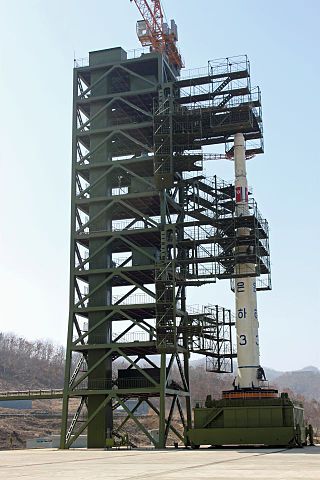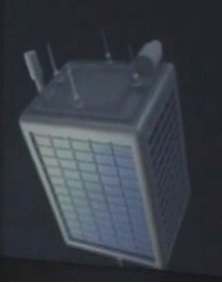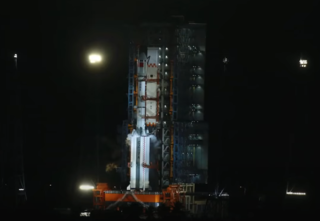The Kwangmyŏngsŏng program was a class of experimental satellites developed by North Korea. The name Kwangmyŏngsŏng is from a poem written by Kim Il Sung. The first class of satellites built by North Korea, the program started in the mid-1980s. There have been five launches so far, of which two have been successful.

The Missile Defense Agency (MDA) is a component of the United States government's Department of Defense responsible for developing a comprehensive defense against ballistic missiles. It had its origins in the Strategic Defense Initiative (SDI) which was established in 1983 by Ronald Reagan and which was headed by Lt. General James Alan Abrahamson. Under the Strategic Defense Initiative's Innovative Sciences and Technology Office headed by physicist and engineer Dr. James Ionson, the investment was predominantly made in basic research at national laboratories, universities, and in industry. These programs have continued to be key sources of funding for top research scientists in the fields of high-energy physics, advanced materials, nuclear research, supercomputing/computation, and many other critical science and engineering disciplines—funding which indirectly supports other research work by top scientists, and which was most politically viable to fund from appropriations for national defense. It was renamed the Ballistic Missile Defense Organization in 1993, and then renamed the Missile Defense Agency in 2002. The current director is U.S. Navy Vice Admiral Jon A. Hill.
Taepodong-1 was a three-stage technology demonstrator developed by North Korea, a development step toward an intermediate-range ballistic missile. The missile was derived originally from the Scud rocket and was tested once in 1998 as a space launch vehicle. As a space launch vehicle, it was sometimes called the Paektusan 1.
The Taepodong-2 is a designation used to indicate what was initially believed to be a North Korean two- or three-stage ballistic missile design that is the successor to the Taepodong-1 technology demonstrator. In 2012, the U.S. Department of Defense assessed that the Taepodong-2 had not been deployed as a missile. The Taepodong-2 is the technology base for the Unha space launch vehicle, and was likely not intended as ICBM technology.

This is a timeline of first orbital launches by country. While a number of countries, incl. Canada, Australia, Germany, Brazil, Algeria, Kazakhstan, Turkey, Argentina, Italy, Malaysia, Poland, South Africa, the Philippines, Egypt, Spain, Mexico, Thailand and Chile, have built or launched satellites, as of 2022, eleven countries, incl. the United States, Japan, China, India, Iran, Israel, France, the United Kingdom and South Korea, have had the capability to send objects into orbit with their own launch vehicles. Russia and Ukraine inherited the capability of the space launchers and satellites from the Soviet Union, following its dissolution in 1991. Russia launches its rockets from its own and foreign (Kazakh) spaceports.
The Space Tracking and Surveillance System was a pair of satellites developed by the United States Missile Defense Agency (MDA) to research the space-based detection and tracking of ballistic missiles. Data from STSS satellites could allow interceptors to engage incoming missiles earlier in flight than would be possible with other missile detection systems. The STSS program began in 2001, when the "SBIRS Low" program was transferred to MDA from the United States Air Force. In December 2002, SBIRS Low Research & Development was renamed Space Tracking and Surveillance System (STSS).

Sohae Satellite Launching Station is a rocket launching site in Tongch'ang-ri, Cholsan County, North Pyongan Province, North Korea. The base is located among hills close to the northern border with China. The spaceport was built on the site of the village Pongdong-ri which was displaced during construction. It was the site for the 13 April 2012 launch of the North Korean satellite Kwangmyŏngsŏng-3, which was launched to celebrate the 100th anniversary of the birth of Kim Il-Sung. The rocket launch failed, but on 12 December of the same year Kwangmyŏngsŏng-3 Unit 2 was successfully launched and brought into Earth orbit.

The Unha or Eunha is a North Korean expendable carrier rocket, which partially utilizes the same delivery system as the Taepodong-2 orbital launch system.

Kwangmyŏngsŏng-2 was a satellite launched by North Korea on April 5, 2009.
The Korean Committee of Space Technology was the agency of the government of the Democratic People's Republic of Korea responsible for the country's space program. The agency was terminated and succeeded by the National Aerospace Development Administration in 2013 after the Law on Space Development was passed in the 7th session of the 12th Supreme People's Assembly.

Kwangmyŏngsŏng-1 or Gwangmyeongseong-1 was a satellite allegedly launched by North Korea on 31 August 1998. While the North Korean government claimed that the launch was successful, no objects were ever tracked in orbit from the launch, and outside North Korea it is considered to have been a failure. It was the first satellite to be launched as part of the Kwangmyŏngsŏng program, and the first satellite that North Korea attempted to launch.

Kwangmyŏngsŏng-3 was a North Korean Earth observation satellite which, according to the DPRK, was for weather forecast purposes, and whose launch was widely portrayed in the West to be a veiled ballistic missile test. The satellite was launched on 13 April 2012 at 07:39 KST aboard the Unha-3 carrier rocket from Sohae Satellite Launching Station. The rocket exploded 90 seconds after launch near the end of the firing of the first stage of the rocket. The launch was planned to mark the centenary of the birth of Kim Il Sung, the founder of the republic. On 1 December 2012 North Korea announced that a replacement satellite would be launched between 10 and 22 December 2012. After a delay and extending the launch window to 29 December, the rocket was launched on 12 December 2012.
Kwangmyŏngsŏng-3 Unit 2 or Gwangmyeongseong-3 ho 2-hogi was the first satellite successfully launched from North Korea, an Earth observation spacecraft that was launched on 12 December 2012, 00:49 UTC, in order to replace the original Kwangmyŏngsŏng-3, which failed to reach orbit on 13 April 2012. The United Nations Security Council condemned the satellite launch, regarding it as a violation of the ban on North Korean ballistic missile tests, as the rocket technology is the same.
38 North is a website devoted to analysis about North Korea. Its name refers to the 38th parallel north which passes through the Korean peninsula and from 1945 until the start of the Korean War in 1950 divided the peninsula into North and South Korea. Formerly a program of the US-Korea Institute at Johns Hopkins University's Paul H. Nitze School of Advanced International Studies, it is now housed at the Stimson Center and is directed by Senior Fellow Jenny Town. Notable contributors include nuclear scientist Sigfried Hecker, former Associated Press Pyongyang Bureau Chief Jean H. Lee, cybersecurity expert James Andrew Lewis, and North Korea Tech founder Martyn Williams.

National Aerospace Technology Administration is the official space agency of North Korea, succeeding the Korean Committee of Space Technology (KCST). It was founded on 1 April 2013. Formerly called the National Aerospace Development Administration (NADA), it changed its name in September 2023 following the 9th Session of the 14th Supreme People's Assembly. The current basis for the activities of NATA is the Law on Space Development, passed in 2014 during the 7th session of the 12th Supreme People's Assembly. The act sets out the North Korean principles of the development of space capabilities as it relates to the principles of the North Korean Juche ideology and independence, as well as the aim of solving scientific and technological problems of space exploration to improve its economy, science, and technology.
The Pukguksong-1 or Pukkŭksŏng-1, Bukgeukseong-1, alternatively KN-11 in intelligence communities outside North Korea, is a North Korean, two-stage submarine-launched ballistic missile (SLBM) that was successfully flight tested on 24 August 2016.
In the year 2016, North Korea conducted two nuclear tests: one in January and the other in September. Additionally, the country conducted several missile tests. As consequence, the United Nations Security Council adopted three resolutions against North Korea.

A small-lift launch vehicle is a rocket orbital launch vehicle that is capable of lifting 2,000 kilograms (4,400 lb) or less or under 5,000 kilograms (11,000 lb) of payload into low Earth orbit (LEO). The next larger category consists of medium-lift launch vehicles.

Shijian is a series of satellites built and operated by the People's Republic of China. Some Shijian-series satellites have drawn significant concerns from the United States government and space observers who cite unannounced launches, undisclosed sub-satellites deployed in orbit, unusual orbital maneuvers, and demonstrated rendezvous proximity operations (RPO) including the close inspection and towing of other satellites.










